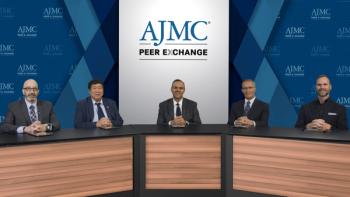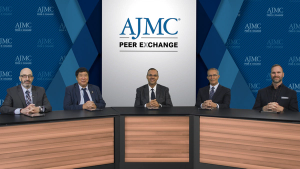
Experts share their final thoughts on the discussion, offering key takeaways and reflections on the importance of lipoprotein(a) (Lp[a]) testing and its role in improving cardiovascular risk management

Experts share their final thoughts on the discussion, offering key takeaways and reflections on the importance of lipoprotein(a) (Lp[a]) testing and its role in improving cardiovascular risk management

Experts discuss lessons learned from implementing lipid-lowering therapy recommendations and explore the role value-based care models may play in successfully adopting the National Lipid Association’s (NLA) recommendation for lipoprotein(a) (Lp[a]) testing.

Experts discuss lessons learned from implementing lipoprotein(a) (Lp[a]) testing in health care systems, how health systems can prioritize patients for testing based on the National Lipid Association’s (NLA) recommendation, the role of integrated delivery networks in helping providers identify priority patients, and strategies for adding electronic health record alerts for Lp(a) testing.

Experts discuss the current prevalence of lipoprotein(a) (Lp[a]) testing in the US, both in the general population and among those with established atherosclerotic cardiovascular disease (ASCVD), its commonality within health plans, and how payers, population health decision makers, and provider groups can integrate Lp(a) testing into broader population health management strategies.

Experts discuss how knowledge of lipoprotein(a) (Lp[a]) levels can empower patients in managing atherosclerotic cardiovascular disease (ASCVD) risk factors, how providers can collaborate with patients on Lp(a) testing and risk management, the potential population-level value of improved ASCVD risk assessment, and how the National Lipid Association’s (NLA) recommendation for one-time Lp(a) testing may benefit health systems.

Experts discuss how lipoprotein(a) (Lp[a]) testing, even without targeted Lp(a)-lowering therapies, can enhance overall cardiovascular risk assessment and potentially influence the management of other risk factors.

Experts discuss FDA-approved therapies for high lipoprotein(a) [Lp[a]) levels, their benefits and shortcomings, the frequency of their use in health plans, emerging therapies in the pipeline, and the expected timeline for associated data release.

Experts discuss how to evaluate the cost-effectiveness of continuous glucose monitoring (CGM) compared to traditional monitoring, considering both clinical and quality outcomes, and what combination of economic and quality data would most effectively support broader CGM adoption across health systems and payer organizations.

Experts share specific examples of how continuous glucose monitoring (CGM) technology has impacted diabetes-related health care costs and quality performance metrics, and discuss the methods used to measure and track CGM's long-term impact on diabetes complications, associated costs, and quality outcomes.

Experts discuss the cost of lipoprotein(a) (Lp[a]) tests and how these costs, along with the National Lipid Association’s (NLA) recommendation and supporting clinical evidence, may influence payer decisions regarding coverage for Lp(a) testing.

Experts discuss whether providers should wait for another complete scientific statement from the National Lipid Association (NLA) or new guidelines from organizations like the American Heart Association (AHA) before implementing the 2024 NLA recommendation for universal lipoprotein(a) (Lp[a]) measurement.

Experts discuss the metrics used to evaluate continuous glucose monitoring (CGM)'s comprehensive return on investment, including both cost savings and quality measure performance, and identify which patient populations demonstrate the strongest combined benefits in costs, quality measures, and outcomes, along with how these groups are prioritized for CGM access.

Experts discuss the impact of continuous glucose monitoring (CGM) implementation on emergency department utilization, hospitalizations, and quality measures including Healthcare Effectiveness Data and Information Set (HEDIS)/Medicare Star ratings, and how CGM adoption has influenced patient encounter patterns, care coordination efficiency, and achievement of quality benchmarks.

Experts discuss the evidence supporting the National Lipid Association’s (NLA) recommendation for universal lipoprotein(a) (Lp[a]) measurement and evaluate how compelling this evidence is from a clinical perspective.

Experts discuss how guideline recommendations influence formulary decisions regarding preventive measures like lipoprotein(a) (Lp[a]) testing, exploring the varying recommendations from organizations such as the American Association of Clinical Endocrinologists, the American Heart Association, and the National Lipid Association (NLA), and how these align with recent guidance from Europe and Canada.

Experts discuss how to evaluate and communicate the return on investment for continuous glucose monitoring (CGM) coverage to overcome cost-related barriers, explore strategies other payers could adopt based on the success of Metro Nashville Public Schools' initiative to provide CGM devices without prior authorization, and examine the impact of removing prior authorization requirements on appropriate patient selection and utilization, along with which aspects of this model could be adopted by other employers and the resources needed to implement similar programs.

Experts discuss the disparities observed in continuous glucose monitoring (CGM) access and utilization with Healthcare Effectiveness Data and Information Set (HEDIS) now stratifying 22 measures by race and ethnicity, and how these insights can inform strategies to improve health equity, along with successful strategies implemented to improve CGM access and technology literacy in underserved communities.

Experts discuss an example illustrating the association between lipoprotein(a) (Lp[a]) levels and atherosclerotic cardiovascular disease (ASCVD) risk and explore how this example can inform our understanding of Lp(a) and ASCVD risk on a population level.

Experts discuss the genetic determinants of lipoprotein(a) (Lp[a]) levels, providing evidence supporting this conclusion. They also explore how the hereditary nature of Lp(a) can drive awareness of atherosclerotic cardiovascular disease (ASCVD) and aortic stenosis risk, potentially influencing screening protocols.

Experts discuss how current coverage policies and prior authorization requirements affect continuous glucose monitoring (CGM) access and adoption rates, and how coverage barriers impact the ability to provide timely CGM access, particularly for patients who could benefit most.

Experts discuss the most significant barriers to continuous glucose monitoring (CGM) implementation encountered in their respective roles and how these barriers vary across different patient populations and care settings.

Experts discuss the evidence supporting the continuous relationship between lipoprotein(a) (Lp[a]) levels and atherosclerotic cardiovascular disease (ASCVD), as recognized by the National Lipid Association, and explore how Lp(a) levels may change throughout a person’s lifetime or in response to lifestyle factors.

Experts discuss the relationship between lipoprotein(a) (Lp[a]) levels and atherosclerotic cardiovascular disease (ASCVD) risk, with findings from a large US population study, and explore how these findings could impact clinical practice and the management of patients at risk for ASCVD.

Experts discuss how the integration of continuous glucose monitoring (CGM) data into electronic health record (EHR) systems enhances clinical decision-making and care coordination, how primary care providers (PCPs) can leverage CGM data integration to provide more comprehensive diabetes care in the context of a shortage of endocrinologists, and the impact of varying coverage policies for CGM across different payers on patient access and outcomes, particularly for patients on basal insulin.

Experts discuss the role of continuous glucose monitoring (CGM)-derived metrics, particularly glucose management indicator (GMI), in the new Healthcare Effectiveness Data and Information Set (HEDIS) diabetes care measures and ACO quality targets, and how CGM-specific metrics are being incorporated into the National Committee for Quality Assurance (NCQA)’s quality measures and the implications for health plans.

Experts discuss the clinical and economic burden of atherosclerotic cardiovascular disease (ASCVD) and aortic stenosis in the US, exploring their impact on health care systems, the importance of prevention in reducing this burden, and the challenges of implementing preventive strategies, while considering the potential benefits of improved risk assessment and prevention in the ASCVD space.

Experts discuss atherosclerotic cardiovascular disease and aortic stenosis, as well as their burden, highlighting their prevalence, impact on patient health, and the growing need for effective management strategies.

Experts discuss the relative value of different continuous glucose monitoring (CGM) metrics (glucose management indicator [GMI], time in range, glucose variability) in assessing glycemic control and how these outcomes vary across different patient populations.

Experts discuss the clinical and practical factors that guide decision-making when recommending continuous glucose monitoring (CGM) vs traditional glucose monitoring for patients with type 2 diabetes.

This program was supported through an independent medical education grant from Dexcom Medical Affairs. Experts discuss how continuous glucose monitoring (CGM) adoption impacts clinical inertia and supports earlier therapeutic interventions across different patient populations, highlighting measurable improvements in patient outcomes, such as glycemic control, hemoglobin A1c (HbA1c) levels, hypoglycemic events, and quality of life.

Published: March 31st 2025 | Updated:

Published: March 28th 2025 | Updated:

Published: April 18th 2025 | Updated:

Published: April 11th 2025 | Updated:

Published: March 14th 2025 | Updated:

Published: April 11th 2025 | Updated:

259 Prospect Plains Rd, Bldg H
Cranbury, NJ 08512
© 2025 MJH Life Sciences®
All rights reserved.
